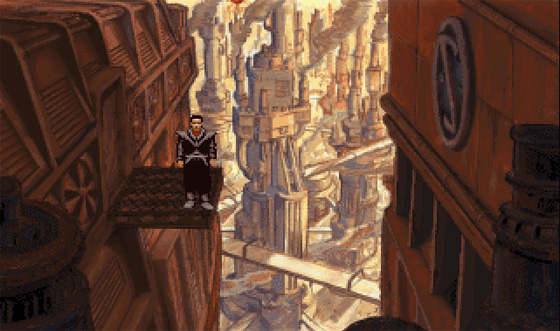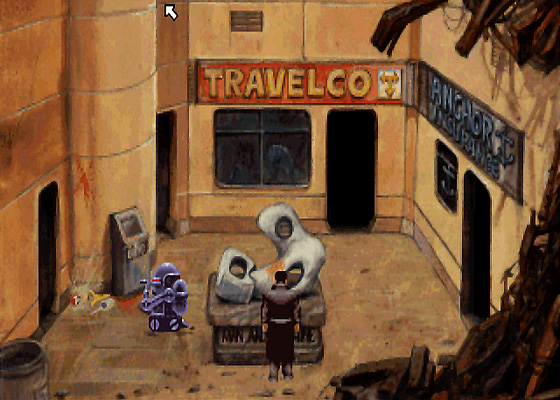The Guilt Trip Over Drip-feeding Through Point and Click Adventure Games
October 15th, 2010
Recently I completed Beneath a Steel Sky (which you can conveniently download from Good Old Games for free) and fessing up it’s probably my all time favourite point and click adventure game. The interface is minimal and elegant, the puzzles largely built on clever logic (that is, you can solve them yourself), the dialogue—while completely misreading Australian culture at times—is sharp and generally laugh-out-loud funny and, finally, the artwork is done by no less than Dave Gibbons of Watchmen fame. So, essentially, Beneath a Steel Sky ticks all the right boxes for an old school adventure fan. However, I may as well say the whole truth while I’m at it: none of this stopped me from occasionally drip-feeding my way through on a FAQ.
It’s a cardinal sin, an invariable trademark of a cheat, I know. The puzzles are the glue keeping the whole experience together, the gameplay in its entirety (apart from dialogue options and random asides) and to dodge the puzzles like this is to basically negate the game altogether. So why is it that when playing point and click adventures, even the good ones like Beneath a Steel Sky, I can’t resist the temptation of peeking at a walkthrough?
http://www.youtube.com/watch?v=lyZrgvoQFNMWell, the genre isn’t all that fun most of the time and by most of the time I mean when the potential solutions to a puzzle aren’t readily apparent to the player. I spend the majority of my time in these games flailing around without a clue on what to do next instead of actively solving puzzles. Granted, Beneath a Steel Sky isn’t as bad as some, it still threw up roadblocks from time to time.
My frustration stems mainly from the imbalance of challenge and guidance. Ideally, as soon as a player obtains a new item, alarm bells should be going off in their head as to where and how they can use the item in conjunction with the environments and props they’ve previously encountered (or, alternatively, just keep it in storage until a future opportunity arises). The game needs to manifest clues throughout the environment, NPCs and props. Furthermore items ought to function as one expects, ie, a knife can be used to cut things and not as something to row a boat with. Through these means, the most reasonable interactions are accepted and the game can lead the player to the goal without giving them the answer.
Metroid and Zelda do this really well. In these games, players will often stumble upon devices/areas that can’t yet be operated or reached until the player gains a certain ability, as such the player makes a mental note of it (or in the case of Phantom Hourglass, they scribble it down on their map). Later in the game when the player finally gains a new ability, they already have a few ideas on where the item/ability might be needed, if not know exactly what to do with it. Furthermore, the abilities/items follow the principle of form fits function and often NPCs, like Navi or villagers, will drop hints. Puzzles in a point and click adventure game follow the same structure where players will first come across a series of situations and then acquire the inventory to solve each dilemma. For example, at the start of The Secret of Monkey Island the player will first make their way through the town, listening to the problems of the towns people before they find the necessary tools to tackle the problems one-by-one. It’s in these first instances of each section of gameplay where the seeds must be planted in the player’s brain.
Another point to consider is that in a point and click adventure items are often used once and then discarded or used up in the one go which means that, unlike the 2 previously mentioned games, the interactions that accompany each item in the inventory often only occur once. Since each item can only be used once, point and click adventures cannot be quite as obvious as a Zelda or a Metroid, otherwise players will solve the problems too quickly. It’s all about striking a balance between challenging and do-able, much of this occurring in the investigation stages of the game.
Now that we have a general idea of when and how these games equip the player for problem solving, we can analyse the puzzles and lead up to the puzzles in Beneath a Steel Sky which made me resort to a FAQ, judging whether the game was reasonable or not. I will use the criteria that I mentioned above (primarily: whether the items fit its reasonably assumed function and how clues and tutorial are internalised within the environment, props and NPCs) as well as evaluating the construction of puzzles. You’ll have to excuse some of the weak explanations as I didn’t note take while I played the game.
The Factory and Upper Levels
Early on, Beneath a Steel Sky follows pretty standard logic and poses little trouble to the player. The inventory is standard factory equipment like an iron bar, WD-40, a spanner and the ID card which interfaces with the LINC terminals. These terminals offer some humourous details on the characters as well as slipping a few hints through. Joey (the smart alec robot) and the NPCs are also very helpful. Otherwise the inventory is rather practical and straight forward (the steel bar has multiple uses as a rod, the spanner is used to undo bolts, the puty to hold things in place etc.). However, the game had set no clear context on how to overload the machine, this part seems rather trial and error due to the needlessly complicated steps involved, even if the items have sensible applications.
I found that as Foster and Joey made progress, the puzzles became a little less practical. For instance, in the upper levels after you drop Lamb’s social status down to a D-LINC (no social rights) in Pott’s factory, you then have to wait for Lamb to ride the elevator to the upper levels and then get stuck as he fails to activate the elevator terminal to get back down. This doesn’t make a lot of sense as you lower his status before he takes the elevator up, so how is he even allowed to take the elevator to the upper levels? Then once you bump into him, you need to exert all dialogue options before the next part is prompted. The construction of this puzzle is longwinded, defies the game’s own logic and is based partly on chance (in that you need to run into him first and can easily miss or overlook the prompt).
Linc Space
Linc Space, the computer program that you can hack into, forced me to use a guide almost for the entirety of these reoccurring sequences. Outside of Anita (who only tells you what needs to be done in Linc Space), this part of Beneath a Steel Sky is really unaccounted for. Foster is transported into the simulation with some arbitrary tools and objects that are given no pre-set explanation. The player knows their objective, but without any context or support behind these random tools, these sequences are mostly trial and error. For instance, I used the unzip tool to open the secret files, but once opened, the examination mechanic (right click) wouldn’t allow me to read the files. This is needlessly impractical.
Belle Vue
On the ground level, the gag with Mrs. Piermont’s dog reminds me of similar joke puzzles from Monkey Island and Grim Fandango. While it’s not as farfetched as using cooking oil to peel the tattooed map off the back of a sun baking pirate, it still falls under the category of humourous at the expense of sound logic. Admittedly, the dog biscuits should be used with the dog, but the rest of the puzzle is contrived.
Linc Base
While there were a few more bumps on along the road, the end chunk of the game, just like the first is fairly straight forward as the Linc base is quite contained and the connection between the environment and the inventory is much clearer. Can’t reach the seal to a shaft? Use the iron bar to prod it open. Can’t enter the lab with the android? Insert Joey’s circuits into a spare robot shell. All very natural interactions given the tools you have available.
In returning to the question (So why is it that when playing point and click adventures, even the good ones like Beneath a Steel Sky, I can’t resist the temptation of peeking at a walkthrough?), the reason is that, as evidence by the examples above, some of the puzzles in Beneath a Steel Sky don’t assist the player in realising the solution, they just send the player in blind. The environments and characters often don’t strongly embed tutorial, so when there’s a tricky puzzle or the tools do not function as the player might assube it all falls apart.
To extend beyond this analysis and into other reasoning, it becomes difficult to refuse using a walkthrough when it comes packaged with the game itself. The fact that a play guide was included, makes the reliance on it easier to bear, as opposed to searching yourself. The presence of the guide suggests that Revolution Studios knew that players would likely get stuck and went to the appropriate means of resolving the problem. And when the player follows this supposition, it’s hard to feel guilty. It’s obviously a band-aid solution that fails to rectify the bad design.
As I continue to play around with this genre, I want to take these design principles a little further in my analysis. For now though, we’ve established a rather handsome base to kick off future research. Please feel free to try Beneath a Steel Sky yourself to see if you agree with my arguments here. The PC version can be found free here, while an iPod version can be bought here.
Additional Reading







 Game Design Companion: A Critical Analysis of Wario Land 4 - $7.99
Game Design Companion: A Critical Analysis of Wario Land 4 - $7.99 Level Design: Processes and Experiences
Level Design: Processes and Experiences Speed Boost: The Hidden Secrets Behind Arcade Racing Design - $5.99
Speed Boost: The Hidden Secrets Behind Arcade Racing Design - $5.99 Adventures in Games Analysis: Volume I - $5.99
Adventures in Games Analysis: Volume I - $5.99







